This was published 5 months ago
‘One of my greatest finds’: Odd discoveries in Nellie Melba’s home
Cigarettes, monogrammed crockery, handwritten letters … cataloguing the Victorian home of famed soprano Dame Nellie Melba opens a treasure trove of intrigue. But some mysteries remain unsolved.
By Melissa Fyfe
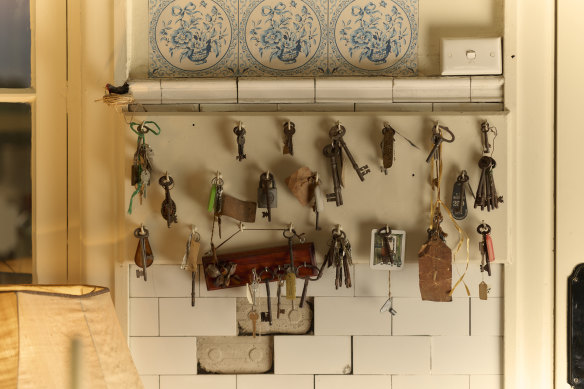
Some of Coombe Cottage’s 1000-odd keys.Credit: Josh Robenstone
One day last year, historian Courtnay Lucas was in Dame Nellie Melba’s sitting room when something caught his eye: a locked drawer. Lucas, 45, has foppish brown hair, glasses and a slightly defeated demeanour, which is understandable because he has a massive task. The descendants of Melba, the first Australian-born international superstar, “the Taylor Swift of her generation”, as art dealer Geoffrey Smith puts it, have employed Lucas to catalogue everything – letters, saucepans, paintings – in Coombe Cottage, the opera singer’s extraordinary home. The Yarra Valley property, an hour’s drive east of Melbourne, is a century-old time capsule, immaculately maintained and protected for decades by Melba’s only grandchild, the very private Lady Pamela Vestey, who died in 2011, aged 92.
For Lucas, two years into the project, Coombe is a house full of little mysteries, like the locked drawer. He spent hours searching for the key. “There are over a thousand keys,” he says, as we look at the drawer in question, part of an exquisite antique writing desk, set with a blue quill and ink pot, a Cartier writing pad and a note written by Melba about an appointment “to hear [a] little girl sing”. This writing is legible, unlike most of her missives, for Lucas a deep source of frustration. (At one point, we study some Melba scrawl. What does that say, I ask Lucas, whose shoulders slump another inch. “I’m a year behind on this project and I feel guilty if I sit down and try to decipher her handwriting.”)
But back to the drawer. It turns out it was full of letters. Sadly, not the juicy ones, like those between Melba and her great love Philippe d’Orléans, the handsome French duke (“What can I tell you of the tender emotion that I have felt again after so many years,” he wrote after their 1919 reunion). Her affair with d’Orléans was so scandalous that her husband Charles Armstrong sued for divorce in 1891 and she lost custody of her only child, George, for 10 years. But there was something else alongside the letters. “This,” says Lucas, his voice hitting a rare note of excitement, “was one of my greatest finds.”
We move to a gallery in the next room that Lucas developed for the guests he takes around the cottage, which opened for small-group guided tours in 2016. The object of Lucas’ excitement is, in fact, packs of “Melba Cigarettes” – an odd product endorsement, one would think, for a singer whose three-octave voice was considered one of the world’s finest. On the packet is her somewhat qualified sales pitch: “I’m inclined to think opera singers ought not to smoke at all, but if they must [her emphasis], well I am sure they could not smoke anything less harmful and more delicious than the Melba Cigarettes.”
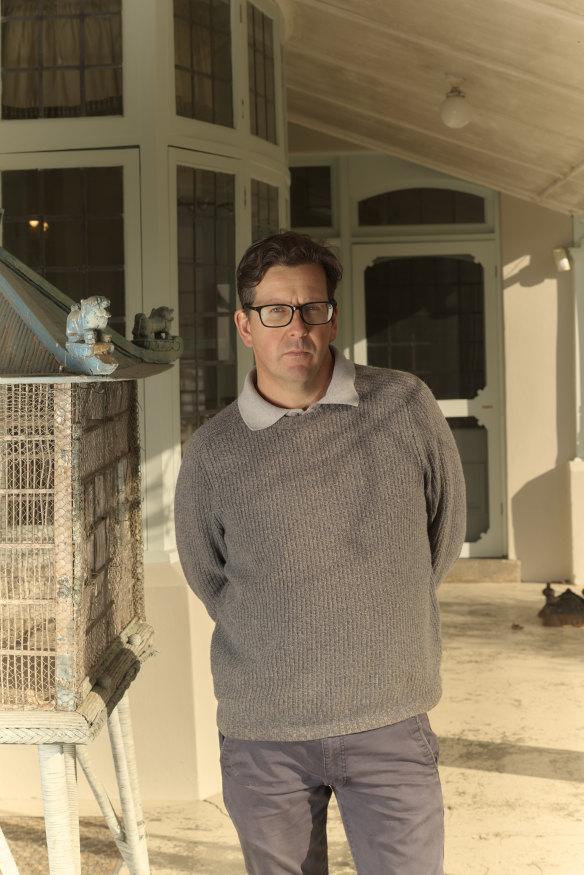
Historian Courtnay Lucas has the painstaking task of combing Coombe Cottage for its secrets.Credit: Josh Robenstone
But surely Melba herself didn’t smoke? “Well!” he says, with a theatrical flourish. “I am starting to doubt that.” If asked on his tours, he’s always said Melba did not. But then he discovered another strange and beautiful object: a thin, bejewelled gold stick, which an app he uses with his phone camera to identify things told him was an Egyptian cigarette holder or roach clip. It’s possible she was gifted it and didn’t use it at all, Lucas concedes, but you never know.
Rattling around this sprawling cottage, Lucas is part detective, part historian. He’s the first family outsider to catalogue all of its contents and, in some cases, the first to put his hand on items untouched for 100 years. It’s a delicate business. He often makes small but important discoveries that require corrections of the Melba record. Wrong information, it turns out, was provided to former tour guests. “I started to doubt everything I was saying on tours because I realised it was nonsense,” says Lucas. Melba’s friend Charlie Chaplin, for example, did not swim in Coombe’s pool. Also, the pool is not the oldest in Victoria. There’s information that must be presented sensitively: the descendants, for example, are not keen on Melba’s allegations of domestic violence against her husband. Then there are other issues the family probably once considered sensitive but now appear comfortable with, such as Melba’s death being likely due to complications from a facelift. It appears there are more layers to Coombe and Melba than on one of her fancy opera costumes.
When I was a child, driving up north on family holidays, we often passed the fortress-like hedge of the Coombe estate, which sits at the junction of the Melba Highway, named in the singer’s honour, and the Maroondah Highway, in the tiny country town of Coldstream. The gigantic, 750-metre-long green wall of cypress obscured the property on all sides and fired my daydreams. How grand was Dame Nellie’s home? What was in it? Who lived there now? Geoffrey Smith remembers this same feeling driving past as a child. “We had no idea what lay beyond,” says the dealer, chairman of art auction house Smith & Singer and, before that, of Sotheby’s Australia.
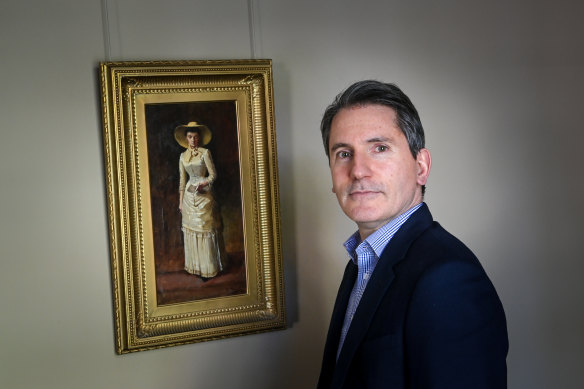
Art dealer Geoffrey Smith organised a controversial auction of Melba’s belongings.Credit: Justin McManus
Many years later, Smith found himself inside the house, choosing pieces for a somewhat controversial 2015 Sotheby’s auction of Melba’s belongings (more on that later). It was, says Smith, thrilling to go beyond the hedge. And so it was for me when, on a trip to the Yarra Valley earlier this year, I visited Coombe’s restaurant and joined the garden tour with Lucas (we closely inspected the hedge, which has little child-sized paths running through it, like something out of The Secret Garden).
Several weeks later, I returned to interview Lucas and take a house tour. Entering each room felt, as Smith says, as if Melba had just left, “swishing her muslin”.
Helen Porter Mitchell, who later adopted a stage name inspired by her home town of Melbourne, was born in 1861, the eldest surviving child of 10 and the daughter of David Mitchell, a shrewd and successful stonemason. While living in Queensland, she met Charles Armstrong, the son of an Anglo-Irish baronet. At 21, she married him and soon gave birth to their only child, George. After a successful singing career in Australia, in 1886 she set sail for London. She auditioned for the famed singing teacher Mathilde Marchesi in Paris and made her opera singing debut in Brussels in 1887, where she was an instant hit as Gilda in Rigoletto. She went on to become the highest-paid singer of her time and often gave private performances for kings, queens, kaisers and tsars, who would pay her in extravagant jewellery.
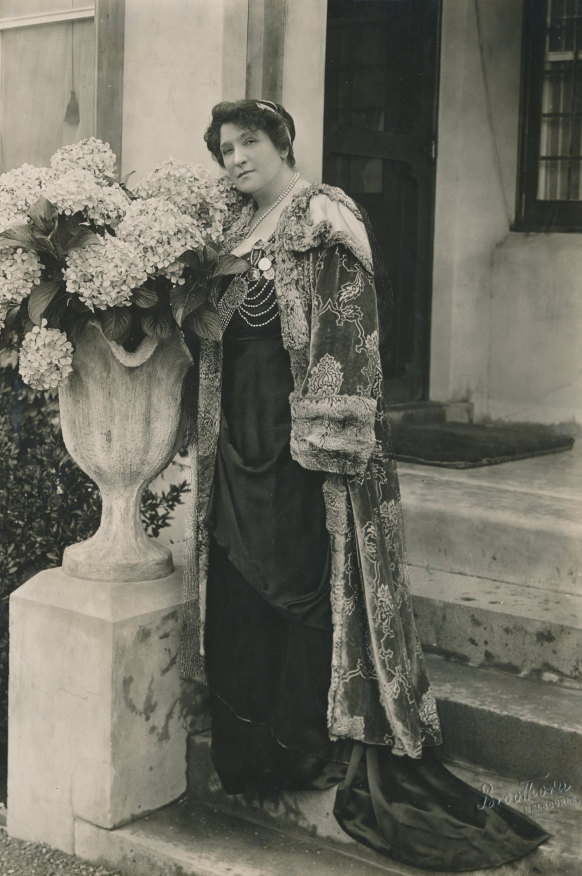
The dame at Coombe Cottage, circa 1915.Credit: Argus Collection, Fairfax Photographic.
But Melba was more than just a celebrity singer. She was a strong, entrepreneurial woman in a man’s world. She had touring companies in America and Australia and her own conservatorium in Melbourne, which fostered new talent. She insisted on being paid royalties for her early gramophone recordings, a technology she helped establish (“Why wasn’t this thing invented before?” she said, after trying out the first electrical recordings). She raised up to £100,000 – about $14 million in today’s dollars – for the war effort, earning her a damehood in 1918. She was ruthlessly competitive and not averse to singing a part from the wings to undermine a rival on stage. She was so beloved that following her death in a Sydney hospital in 1931, aged 69, 5000 people filed past her coffin at Melbourne’s Scots Church. “Is it too much to say,” asked The Argus newspaper, “that she was the greatest Australian?”
Melba was 48 when she purchased the original little farm cottage that was to become Coombe during her “sentimental tour” of Australia in 1909. She had spent much of her life on the road – travelling from homes in London and Paris – but Coombe became her main base as her career wound down. She bought the property fuelled with homesickness and childhood memories of the Yarra Valley, where her father owned a quarry. Her Australian home, she said in her 1925 memoir, was built “almost within sight and sound of the same trees and vineyards in which I played as a child, under the same brilliant sunshine”. Whatever songs were still to sing, she said, “I shall always come back to rest in the shadow of the blue mountains.”
“Is it too much to say,” asked The Argus newspaper, “that she was the greatest Australian?”
Her father warned her off the cottage, saying it was poorly built. He was right: plaster fell off the walls in Melba’s time and still does. He said it was too windy. Correct again. Melba planted the huge hedge as a windbreak. Notwithstanding these issues, in 1911 work began on an extensive renovation that would subsume the old cottage. The end product, a single-storey nine-bedroom home with wisteria-fringed verandahs, was not outwardly ostentatious. But, as one magazine noted at the time, it was a country residence befitting “a gentleman of large wealth and artistic tastes”, the interior a “symphony of architecture and furniture”.
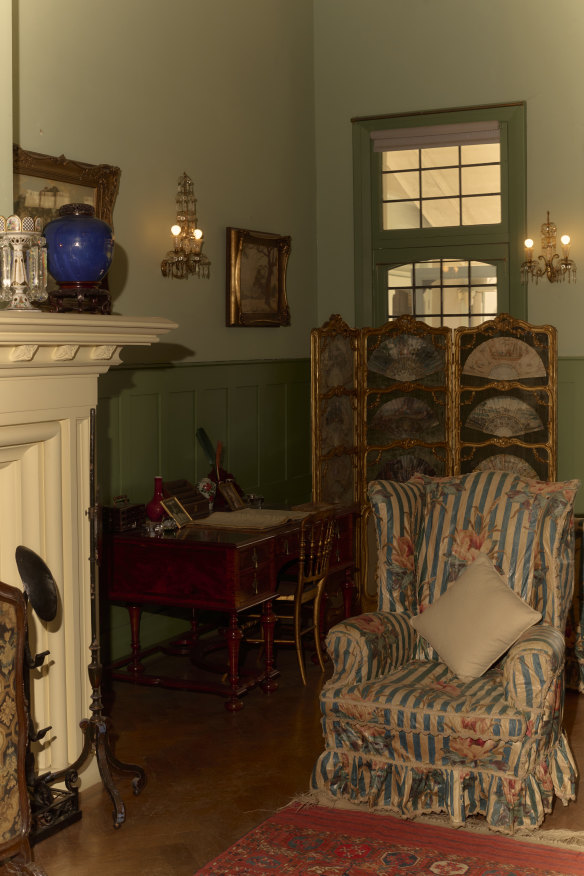
Each room feels “as if Melba has just left”.Credit: Josh Robenstone
The large garden around the home was designed by Melba with input from William Guilfoyle, the former director of Melbourne’s Royal Botanic Gardens. There Melba hosted gala parties for prime ministers, celebrities and newspaper magnates, stringing Japanese lanterns across the tennis court and serving food under the rooftop pergola (now taken down). Joan and Daryl Lindsay, who would go on to write Picnic at Hanging Rock and serve as director of the National Gallery of Victoria respectively, once arrived to find Melba “on the lawn in a brilliant Chinese coat, looking almost as exotic as a pair of macaws she was feeding”.
Melba asked her son George to keep Coombe “as though I were still there; as I have put my life’s blood into this beloved little spot”. She had doted on her only grandchild, George and Evie Armstrong’s daughter Pamela, who was 12 when the singer died. It was Pamela who would become the most important figure in keeping Melba’s legacy alive, while having a somewhat tragic and extraordinary life herself. She fell in love with a man called Captain William Vestey, who belonged to what was then reportedly Britain’s second-richest family. William Vestey’s grandfather, another William Vestey, had co-founded a global meat processing empire. The family also owned large cattle properties in Australia and Argentina and was aided in their wealth creation by a generous English tax loophole. The older William Vestey was ennobled in 1922, apparently for providing food during World War I, but he’d actually bought his baronetcy in a cash-for-honours scandal.

Melba with her son George Armstrong, who was taken to America as a child by her estranged husband Charles.
Lady Vestey’s husband was tragically killed in action during World War II in 1944, leaving her the single mother of two young sons, Sam and Mark. The three briefly lived at Coombe before returning to England so that the boys could attend the elite Eton College. At 13, Sam became Lord Vestey on the death of his grandfather (being close to the British royal family, he would later rise to the rank of Queen’s Master of the Horse). He was immortalised in the Paul Kelly and Kev Carmody song From Little Things Big Things Grow, which detailed Aboriginal stockman Vincent Lingiari’s battle against land dispossession and poor working conditions and pay on Vestey-owned land. The Vestey fortune has been much diminished in the last few decades, but remains healthy: this year’s Sunday Times Rich List put it at £730 million ($1.4 billion).
Lady Vestey returned to Coombe around 1973 after her parents George and Evie, who had lived with her in England, died. Coombe became Lady Vestey’s home-behind-the-hedge, and although she hosted historical society meetings and visits from the local school, it was closed to the public. After her death in 2011, Sam and Mark Vestey oversaw a $3 million restaurant and cellar door development. After Mark’s death in 2016 and Sam’s in 2021, responsibility for the property passed to Mark’s widow Rose and Sam’s daughter Saffron, with Rose’s children Tamara and Nina also taking active roles.
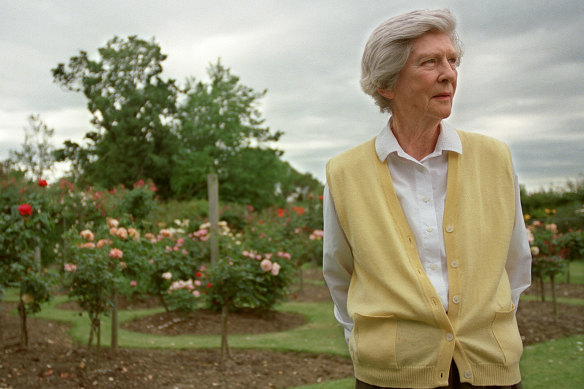
Pamela Vestey, Melba’s beloved granddaughter, who lived in the house for decades.Credit: Marina Oliphant
From her Cotswolds Hills farm in Gloucestershire, a warm and friendly Rose Vestey tells Good Weekend that this generation of Vestey managers are all female. “Coombe was established and managed by an extraordinary woman at the turn of the last century and I’m very proud of the fact that it’s being overseen at board level by strong, capable women.” These women are thinking about new ways to invite the public in, including accommodation options. But first they want everything catalogued properly, finally. Which brings us back to Courtnay Lucas and his big job.
That musty smell of old places hits you when entering Coombe Cottage. The foyer, where Lucas meets me, is wood-panelled and dim, the darkest room in the house. Like the rest of the home, there’s an eccentric mix of items Melba collected during her life: a Chinese fish bowl, for example, next to an English clock.
Lucas, who has an arts degree in history and international relations, hadn’t done any cataloguing before he took on this job; a gallery and museums expert had to visit to show him the ropes. But when he’s not at Coombe three days a week, Lucas leads educational walking tours around Melbourne. During this work he became fascinated with a bunch of extraordinary Victorian women of the early 1900s. These include Melba, of course; the swimmer and actress Annette Kellerman; the cosmetics mogul Helena Rubinstein, who opened her first shop in the city’s Collins Street; suffragist Vida Goldstein; and Janet Clarke, who invented The Ashes urn. “They were all in Melbourne at the same time and … were connected in some way,” says Lucas, who is writing a book on these women – working title Bachelor Girls on Collins Street – that he hopes will one day be adapted to a television series.
We cross the foyer to the ornate dining room. Its centrepiece is a long table set with Melba’s monogrammed crockery. It wasn’t unusual for someone of Melba’s standing to stamp her initials on things, but the sheer number of items she monogrammed is quite something: everything from the iron gates to the picnic set napkins. This is another source of frustration and mystery for Lucas, because the monograms change. Sometimes they’re spidery and cursive, sometimes simple and sometimes even backwards, like the MN on the pots and pans. “I still don’t know why that is the case,” he says later in the kitchen, shaking his head.
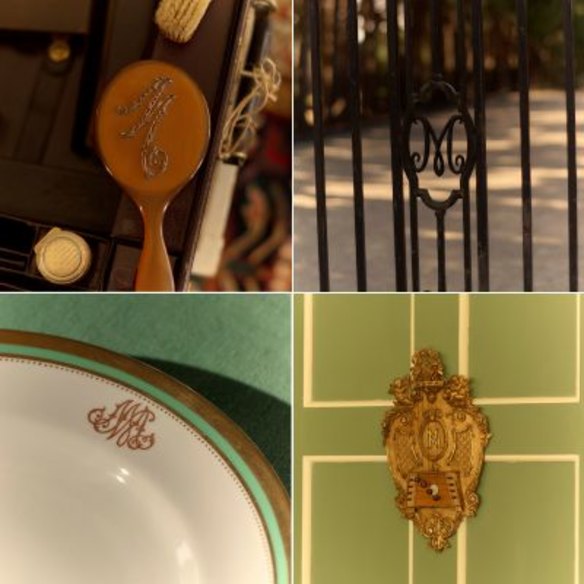
Melba monogrammed many of her belongings – everything from hairbrushes and plates to the Yarra Valley property’s iron gates. “She’s extremely vain and egocentric. No doubt about it,” says Courtnay Lucas, who is puzzled by the varying styles of initials used.Credit: Josh Robenstone
There are other little puzzles all around. For example, it seems the house was mothballed and empty for more than 20 years at one point. “The guest book stops in 1949 and then starts again in 1973 [when Lady Vestey returned from England],” says Lucas. Also, there’s the odd fact that the house has only just been listed on the Victorian Heritage Register (Lucas suspects Lady Vestey did not want outside interference), and there are things on an old insurance list that he can’t find.
The gallery holds several little books in which Melba listed her spectacular gifts from European nobles: diamond and blue enamel brooch, diamond and opal pendant, locket of sapphire and diamonds. It makes you wonder where it all went. The answer, kind of, is everywhere. When she died, many pieces were bequeathed to her extended family. In 1977, Lady Vestey donated Melba’s exquisite opera costumes, accessories, scores and letters to the Performing Arts Museum at Arts Centre Melbourne (now called the Australian Performing Arts Collection). Then, in 1998, she donated documents, some jewellery, books, objects and photos to what is now the Yarra Ranges Regional Museum. Many pieces of jewellery and other Melba paraphernalia still turn up regularly in auctions. Former Liberal powerbroker Michael Kroger bought one of Melba’s Fabergé brooches, given to her by Russian tsar Alexander III, at auction in 2004 for $5750. Lord Vestey and his late wife Celia Vestey were believed to have discreetly sold Melba’s Cartier Devant-de-Corsage necklace in 2018.
The biggest single Melba auction was the one run by Sotheby’s in 2015, when Geoffrey Smith went into Coombe and Lady Vestey’s bank vault and chose 162 lots for sale. They included much of her Australian art collection, featuring works by many female artists, which Heritage Victoria called “amongst the most representative collection of Australian paintings to be found”. Almost all of her Arthur Streetons, a Cartier hair pin and clock, her writing box and even a 19th-century fly swat went under the hammer. The auction, prompted by a cost-blowout in roadworks connected to the restaurant and cellar door development, made nearly $2 million.
Some, like Melba expert Sue Thompson, the immediate past president of the Lilydale & District Historical Society, thought the auction dissipated the unique Coombe collection and would have met with disapproval from her friend Lady Vestey. “I was absolutely shocked when I found out and got the catalogue. I was just in tears,” she tells Good Weekend. When I ask the National Trust’s Annette Shiel about it, she says they would “definitely approach our own collections differently”. Shiel, the executive manager of collections and cultural projects, says that when the trust is given a house with its contents intact – which they call “fully provenanced” – everything is kept. In the case of Joan and Daryl Lindsay’s house Mulberry Hill, on the Mornington Peninsula, even a scrap of soap Joan left on the wash basin was given a catalogue number.
But others, like biographer Ann Blainey, are unfazed. “Melba was constantly being given gifts,” she says. “Cupboards were packed with them.” And Smith stresses his selection in no way diminished the Coombe experience. “You wouldn’t even have known I had been there.” It was better, he says, to give these items another life. “Really, in a way, some of these objects were dead, they were living in the bank vault, the valuable ones. No one was looking at them, no one was enjoying them. They couldn’t be on display or lent anywhere.” Heritage Victoria’s Marina Jansen, who assessed Coombe for the register, says the property remains unusual. “I was somewhat awestruck. The intactness, the original fittings and wallpaper, Melba’s piano. In some of the rooms it is literally like she’d just been there a few weeks ago.” (Coombe was listed around the same time as Mooramong, the house of Hollywood silent movie star Claire Adams, as part of Heritage Victoria’s “enrichment project” to protect the houses of important women.)
I ask Rose Vestey how she thinks Lady Vestey would have felt about the auction. “I know Sam and Mark searched their souls and found it all incredibly difficult. But we’ve put that behind us now. And we’re committed to finding alternative ways to fund and support Coombe.”
Standing in the kitchen, I wonder whether Melba, with her retinue of servants, would ever have cooked here. Yes, says Lucas, there’s a story about her cooking bacon and eggs in the middle of the night for a visiting jazz band. The day before she’d invited them into her bedroom. “This is the holy of holies,” she was reported to have said. “Everyone wants to say they’ve lain on Melba’s bed. Go on, lie on it!” Melba’s bedroom, which we visit next, is almost as she left it – except for a bit of ceiling cornice that fell down over Christmas.
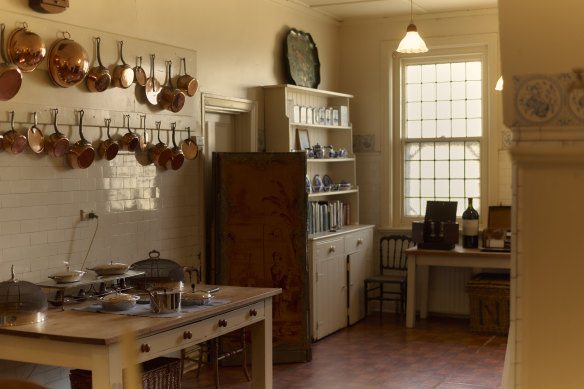
The kitchen, in which Melba reportedly cooked bacon and eggs in the middle of the night for a visiting jazz band.Credit: Josh Robenstone
This is the thing: old houses constantly need repairs. The Vestey family, which long ago divested itself of many of its Australian landholdings (I raised the Paul Kelly-Kev Carmody song with Rose, but she said she wasn’t aware of it) takes the view that Coombe must be financially self-sufficient, though they support it when necessary. The property supports a thriving wedding business and its restaurant, cellar door, garden and house tours run five days a week. Proceeds from these activities cover the costs of looking after a heritage property, but in 2021 experts were engaged to assess major structural problems caused by the cottage’s shallow footings. “It is a very big challenge,” says Rose. “But we have a dedicated team of people, colour conservators, heritage consultants, architects, builders, you know, everyone is addressing the challenge.” (The Vesteys, who receive no government funding to maintain the building, face a similar challenge to those running the houses of other famous Australian artists. The Adelaide Hills home of landscape painter Hans Heysen – who stayed at Coombe – has required millions of dollars in government funding. Everyone wants these places to be preserved and opened, but they can also be money pits.)
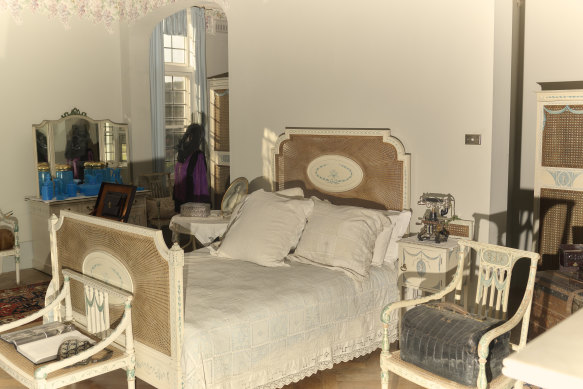
Melba’s bedroom, which she reportedly described as “the holy of holies”.Credit: Josh Robenstone
As we move down the hallway – the place has seemingly infinite hallways – past the Japanese-inspired wall frescoes, I can hear Melba singing, a tinny trill floating from a room somewhere. The early technology used to record Melba’s soprano was notoriously bad and sometimes made her sound out of tune. I ask Lucas whether her voice was really a once-in-a-generation phenomenon. “The biggest criticism was that she was too perfect,” he says. “She didn’t have much emotion in her voice, that’s all [the critics] could come up with. But she was technically the best, probably the best ever, because they don’t sing like that any more.”
One thing that’s tricky for Lucas is handling Melba’s allegations that Charles Armstrong was violent. The Vesteys believe Melba would never have wanted to be seen as a victim. And they believe that because Melba made the allegations amid a custody dispute, the singer might have been trying to further her case. Lucas is always careful, on his tours, to say Melba alleged these things, rather than assert them as fact. But biographer Ann Blainey says she’s “inclined to believe [Melba] was speaking the truth”. What worries Blainey, though, is that, on a pre-COVID visit to Coombe, one of the female guides assured her Melba had given her permission for George to be taken to America. Blainey details in her book that Melba tried to make George a ward of an English court to stymie Armstrong from taking him to the US. Blainey responds: “I can imagine what Melba would have said to this!”
Towards the tour’s end we’re in another hallway near a giant trunk. Lucas tells me he’s tried to get to the bottom of many Melba myths and conspiracy theories. There was one story, for example, that she had been driving when her car hit and killed a man in Paris (at the time it was reported that her chauffeur was at the wheel). But he can’t find anything to prove it. The truth is elusive with Melba, partly because, in her lifetime, she was so skilled at cultivating Brand Melba. Beverley Nichols, ghostwriter of her 1925 memoir, complained that she wanted “to appear as an angel of sweetness and light”.
But the close study of a bunch of 100-year-old menus has led to another one of Lucas’ prized discoveries. It’s small, yes, but significant. Melba is famous in Australia for several things. Before John Farnham, she was a byword for having endless farewell concerts. “Doing a Melba,” it’s called. She also has four dishes named after her: peach Melba, Melba toast, Melba sauce and Melba garniture (tomatoes stuffed with chicken, truffles and mushrooms). “Taylor Swift doesn’t have four dishes named after her,” Lucas points out. (Only a matter of time, I reply.)
All the dishes were invented for her by Auguste Escoffier – “king of chefs and chef of kings” – at London’s Savoy Hotel. When Escoffier recalled the origin of peach Melba decades later, he said he served the syrupy peach dessert to the singer on the back of a swan carved from ice, a nod to Melba’s performance that week in the opera Lohengrin, which features a swan boat. But Lucas has worked out that a proto peach Melba – a dessert Escoffier named pêches violées á la Nedda – first appeared on a menu for her birthday dinner at the Savoy in May 1893 after she performed Nedda in Pagliacci. “It’s quite a controversial discovery because for well over 100 years chefs have been presenting the dessert in iced swans,” says Lucas.
Lucas has now catalogued everything in the cupboards and drawers, including 2500 letters and photos, with one exception – the contents of one drawer remain a mystery because he cannot find the key. The next thing is to put everything else into the catalogue system, which he estimates could take “ages”.
I ask what’s in the giant trunk. He sighs, as a faraway door opens and another tour begins. “I have moments where I think I’m getting on top of this and then I remember I still haven’t opened that yet.” He lifts the trunk lid and we try to discern its organising principle. I see feathers, lamp shades, a sword. “There was a creepy doll in here at one point,” Lucas says. Do you think the house is haunted? “Some do.” It’s not great when it’s dark, he says; the rattling wind, the slamming doors, the banging windows. “I could write a horror movie with the amount of weird experiences we’ve had in here. But they are all explainable.”
I wonder whether Lucas is trapped with a ghost he dislikes. Is he fond of Melba? “She’s extremely vain and egocentric. No doubt about it. I mean, just look at the monograms!” But he often thinks about the time she was asked whether she wanted to be a duchess. “There are lots of duchesses but only one Melba,” was her retort. When he tells this story on tours, some people react as if she’s a horrible person. Perhaps it’s that very Australian instinct to lop the tall poppy. Others, he says, consider the comment brilliant. As does Lucas. “I think she’s amazing.”
To read more from Good Weekend magazine, visit our page at The Sydney Morning Herald, The Age and Brisbane Times.